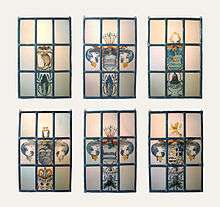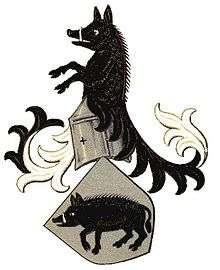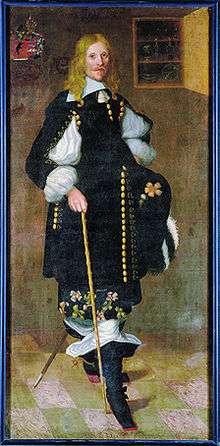Galtung (noble family)
Galtung was a Norwegian noble family dating from the ennoblement of Lauritz Galtung in 1648. However, when he was ennobled, documents exist that indicate that the family descended from an older noble family, the Galte family. A male-lineage connection between these two families has not been identified, but a female-line linkage bridging between them has been documented in genealogical records.[1]


The old family, Galte
The first family called Galte, belongs to what was called the uradel (i.e., undocumented as nobility by letters of patent, but widely recognized as nobility in other sources) in the middle ages. The Galte family male-line apparently died out in ~1413. They had their main seat at Torsnes in Jondal, Hardanger. It is believed that the descendants living today represent the oldest surviving noble family in Norway. [2]
The present family, Galtung

The existing Galtung family male-line can be traced back to Laurits Johanneson who was born around 1519. It was his great-grandson Lauritz Galtung, Admiral of the Dano-Norwegian fleet, who later renewed the nobility of the family in 1648, changing the name from Galte to Galtung. The present family belonged to an influential circle of families in the Hardanger area, including the owners of the farms Aga and Torsnes, and had many well-known naval officers, including admirals .[3][4]
In 1885, historian Henrik Jørgen Huitfeldt-Kaas said that in the period 1670-1870 the family started marrying commoners, and thus, should be considered to have lost their nobility (later it was asserted that this position was influenced by the Danish, whose nobility, to a large degree, supplanted Norwegian nobility during the Dano-Norwegian period. Early in the 18th century the remaining family lived on the old family farm of Torsnes, which is still occupied by descendants today. By the end of the 18th century, many of the family's members could be found in the cities, populating professional classes as lawyers, doctors and such.
Living descendants today include sociologist Johan Galtung, recognised for his contributions to peace research and practice of conflict-solving, the so-called transcend-method. According to Statistics Norway 100 persons have Galtung as their surname as of 2009.[5]
References
- Jon Gunnar Arntzen. "Galtung – norske slekter". Store norske leksikon. Retrieved June 1, 2017.
- "Torsnes (Jondal)". Slektshistoriewiki. Archived from the original on July 22, 2017. Retrieved June 1, 2017.
- "Lauritz Galtung". Slektshistoriewiki. Retrieved June 1, 2017.
- "Galtung (slekt)". Slektshistoriewiki. Archived from the original on July 22, 2017. Retrieved June 1, 2017.
- Statistics Norway - Navnesøk
Literature
- Galtung, Johan Ellertsen: Galtungslekten i fortid og nutid, Oslo 1997.
- Huitfeldt-Kaas, H.J.: De nulevende Adelsslægter i Norge, Christiania 1885.
- Huitfeldt-Kaas, Henrik Jørgen m.fl.: Norske Sigiller fra Middelalderen, Oslo 1899-1950 (seals no. 928, 946, 1089 og 1308)
- Steffens, Haagen Krog: Norske Slægter 1912, Gyldendalske Boghandel, Kristiania 1911
- C. M. Munthe: «Norske slegtsmerker» (Norwegian family emblems), Norsk slektshistorisk tidsskrift, Vol. I, Oslo 1928, pages 32 ff and 155 ff, especially page side 188 and the illustrations no. 189-192
- Haukanes, K. og Jon : Segl og bumerke frå Hardanger, Oslo 1944, pages 23, 101, 248, 281
- Cappelen, Hans: Norske slektsvåpen (Norwegian family coats of arms, with a summary in English), Oslo 1969 (new edition 1976) (with a modern heraldic bookplate in color and a new drawing of the shield in a modern style)
- Løvenskiold, Herman L.: Heraldisk nøkkel, Oslo 1978
- A. Thiset og P.L. Wittrup: Nyt dansk Adelslexikon, København 1904
- Achen, S. T.: Danske adelsvåbener, København 1973